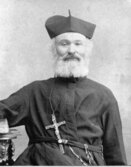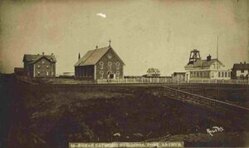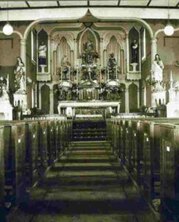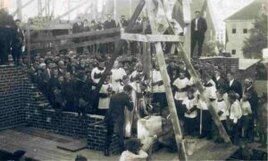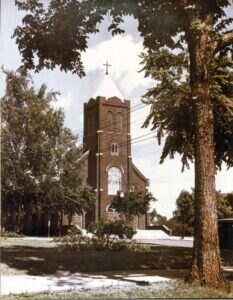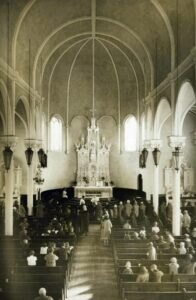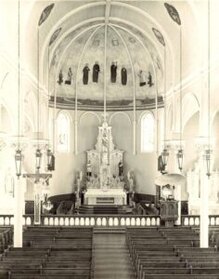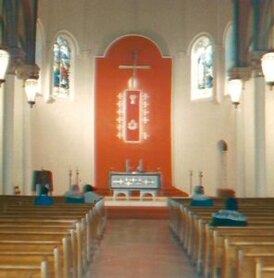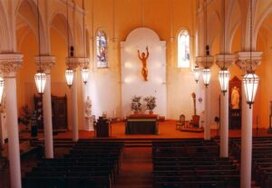|
St. Andrew’s was the first Roman Catholic Parish to be established on the north side of the City of Thunder Bay (formerly Port Arthur) and for many years played a major role in the development and growth of the Catholic Faith in Northwestern Ontario. In 1867, the government approached surveyor, Simon Dawson with regard to the construction of a road linking Lake Superior to the Red River. Dawson and his crew of men from Glengarry, Ontario set about the task of clearing a 30 acre town site and, as construction increased through 1870, the town began to enter a boom phase. It was during this time that the church authorities began to recognize the need for a full-time priest to serve the spiritual needs of the growing population. CONSTRUCTION OF THE FIRST CHURCH Toward the end of 1872, Simon Dawson and Dr. A. J. McDonnell began negotiations to obtain Crown land on which to build a permanent church structure. On September 17th, 1873, 3 fl acres of land were granted to the Roman Catholic Diocese of Hamilton for the establishment of a Catholic church. Fr. Richard Baxter, S.J., immediately began raising funds for the project and construction began on a small wooden building located on the corner of what is now Red River Road and Algoma Street. By the summer of 1874, Bishop Jamot declared the building open for public worship, and sang the first High Mass in it on August 30, 1874. In 1875, Fr. Baxter dedicated the church to the patronage of St. Andrew, the Patron Saint of Scotland, in recognition of the Scottish workers from Glengarry who were the largest donors to the project. Sadly, on February 6th, 1881 tragedy struck and the church burned to the ground. |
|
RISING FROM THE ASHES By the summer of 1881, construction began on the second church; a 40′ x 70′ brick structure with a two-storey addition at the rear of the building which served as a school and sacristy. On the last Sunday in August 1881, Bishop Jamot sang the first High Mass in the second St. Andrew’s Church building and in July 1882, he traveled from Peterborough, once again, for the dedication ceremony of the new church. Within a year, a fire destroyed the vestry, altar and some of the pews and windows. The fire damage had been completely repaired and the church refurnished by Christmas 1892. Through the generosity of a parishioner, a decade later further renovations were made to the interior of the church and the project was fully completed in 1903. |
|
|
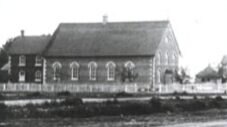 St. Andrew’s 2nd Church Building (circa 1883) |
|
The parish served as a home base of Jesuit missionary activity in the region for many years. After the Fort William Mission just south of present day Thunder Bay, ended its operations in 1906, St. Andrew’s became the headquarters for the region. St. Andrew’s missionaries served as chaplains to the Canadian Pacific Railway workers and their families along the northern shore of Lake Superior. Through the experiences of the Jesuit missionaries, the parish continued to be exposed to a regional perspective in the development of Roman Catholicism in North Western Ontario. |
|
A GROWING PARISH COMMUNITY With the increasing population in the area in the early 1900’s, it became evident that the second church structure had become too small to support the community it was serving. During the first pastoral visit by Bishop David Scollard, of the Diocese of Sault Ste. Marie, to Port Arthur in 1905, St. Andrew’s Parishioners announced their intentions to build a new church. The design process that followed became a challenge due to the differing visions held by Bishop Scollard and the parishioners of St. Andrew’s. |
|
In the meantime, Bishop Scollard granted permission to relocate the current (second) church to the extreme eastern end of the property in anticipation of the new construction which would begin in the fall of 1908. However, construction of the new church would be delayed for another 16 years due to ongoing issues related to the design and funding of the project. Finally, with the approval of a scaled down design and the accumulation of the necessary funding to begin the project, construction was initiated in the summer of 1924 and Bishop Scollard presided over the laying of the corner stone on July 13, 1924. ADDITIONS AND RENOVATIONS In the years that followed, the exterior of the building had undergone changes to include the installation of stained glass windows in 1938, redesign of the stairs at the front of the facade to include a ramp for accessibility and the addition of an elevator. |
|
The interior of the church has seen the most significant number of changes with the addition of a Casavant pipe organ in 1930 which was followed by three alterations to the sanctuary during the Jesuit years. The 1940 alteration was more of an enhancement to the original design and included paintings of the Canadian Martyrs by Scott Young which were added to the dome of the sanctuary. A raised pulpit was erected to the right of the altar and a large crucifix to the left. Changes ushered in by Vatican II, however, resulted in the second more major renovation in 1969 with the removal of the high altar and the addition of the new altar where the priest would now face the congregation for the consecration of the Holy Eucharist. A third renovation in 1983, resulted in the installation of a wooden sculpture of the resurrection of Christ created by artist Janet Marston as the focal point behind the altar.
|
|
POST JESUIT YEARS 1999 marked the departure of the Jesuits from St. Andrew’s Parish after 125 years of service. Responsibility for the pastoral needs of the parish was turned over to the Diocese of Thunder Bay. The fourth and final renovation to the sanctuary resulted in the incorporation of the original high altar from the second church building and the installation of a new stained glass window to mark the 2000 Jubilee Year which was unveiled to celebrate the Feast of St. Andrew on November 30th, 1999. From 2001 to 2004, a Capital Campaign was launched to raise $260,000 to Rebuild, Restore and Preserve the church building. Funds from this campaign were used for the addition of an elevator, restoration and cleaning of the stained glass windows as well as major renovations to the kitchen and halls in the church basement. |
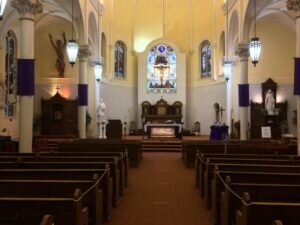 Interior Renovation 1999 |

